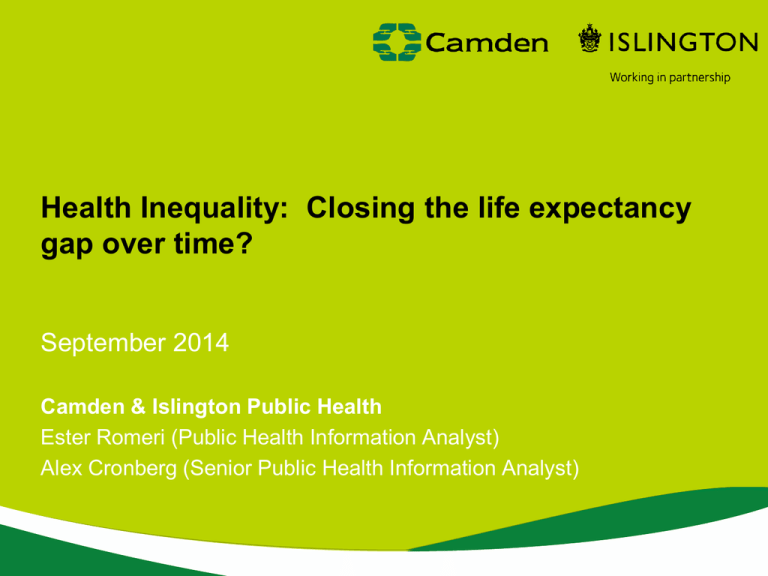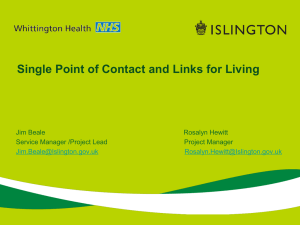
Health Inequality: Closing the life expectancy
gap over time?
September 2014
Camden & Islington Public Health
Ester Romeri (Public Health Information Analyst)
Alex Cronberg (Senior Public Health Information Analyst)
Purpose of this slide set
Reducing the level of health inequality is a priority for both Camden and Islington Councils and Clinical
Commissioning Groups. This slide set is intended to inform Camden and Islington public health teams
and CCGs about causes of death contributing to changes in the life expectancy gap over time.
Specifically, this slide set shows how the gap in life expectancy between the most and least deprived
areas have changed over time in Camden and Islington, and analyses the causes of death contributing
to these changes.
Summary
The life expectancy gap between people living in the most and least deprived areas has increased for
women in Camden, whereas there has been no consistent change for men in the borough.
For men and women in Islington the life expectancy gap has narrowed.
The widening gap for women in Camden is largely due to more deprived women falling behind in terms
of CHD/MI and stroke deaths. Specifically, the death rate for CHD/MI has fallen notably in the least
deprived quintiles, while it has remained fairly unchanged in the more deprived ones. For stroke there
has been a much more substantial drop in the death rate for women living in the single least deprived
quintile than for other women.
The narrowing gap for men and women in Islington is due to fewer deprivation attributable deaths for
CHD/MI and COPD for men and CHD/MI, lung cancer and stroke for women. There has been no clear
trend driving these changes. Some of it is explained by falling death rates in more deprived areas, but
for stroke there has been an increase in deaths in the least deprived quintile.
Despite the narrowing life expectancy gap overall, the mortality gap has widened for heart failure for
men and women in Islington. This is due to a falling death rate in least deprived quintile while there has
been no consistent change for the other quintiles. This pattern is seen for both men and women.
Methods
The analysis presented in this slide set quantifies the inequality gap in mortality by measuring the proportion of
deaths that can be attributed to deprivation. The main measure that has been applied is population
attributable risk. This measure calculates the age standardised death rate for each deprivation quintile and
uses the rate for the least deprived quintile as reference rate. It then calculates the number and proportion of
deaths in the other quintiles in excess of the reference rate.
Note that this means a negative value may be produced if the least deprived quintile does not have the lowest
death rate.
The causes of death covered in this analysis include stroke, coronary heart disease (CHD)/myocardial
infarction (MI), chronic liver disease (CLD), chronic obstructive pulmonary disease (COPD), heart
failure, and lung cancer. These causes are common causes of death that tend to be related to deprivation.
Data on cause of death are based on ONS mortality files for 2006 to 2012. The data have been grouped into
five-year periods to ensure the numbers are large enough for robust analysis.
Data on deprivation are based on the Index of Multiple Deprivation (2010), with small areas (Lower Super
Output Areas) in Camden and Islington grouped into five equal groups (quintiles) within each borough based on
their deprivation score. It should be noted that deprivation quintiles are not comparable across Camden and
Islington.
Other inequality measures have also been applied, with results available in the summary tables in the
Appendix. These measures show consistent results with the population attributable risk.
Analysis on health inequalities for both prevalence and deaths for long term conditions has also been
conducted for both boroughs and is available on request. That analysis was presented at the Health Inequality
Network Conference at Kings College in May 2014.
Deprivation level
These maps show small areas* grouped into
deprivation quintiles within each borough (based
on the Index of Multiple Deprivation (IMD) 2010).
Note that since the overall level of deprivation is
different in the two boroughs, the deprivation
quintiles are not comparable.
CAMDEN
In Camden there is a clear geographical pattern
with respect to deprivation. In Islington there is no
such clear cut pattern. Instead, the most and least
deprived people live side-by-side within small
areas.
The lack of a distinctive geographical pattern in
Islington means the full extent of inequalities in
the borough is probably not captured by the Index
of Multiple Deprivation. This is evident from
analysis done by the ONS using occupational
groups. This shows that Islington has the largest
health inequality gap in England for both men and
women when based on occupational groups and
self-reported good health. For comparison,
Camden ranks third and seventh for men and
women respectively (Source: ONS 2013).
* Lower Super Output Areas
(LSOA). Each LSOA has a
population of about 1,500
people.
ISLINGTON
Background: Overall deaths
Trend in deaths per 100,000 population, Camden and Islington,
1996-98 to 2010-12
The overall death rate in
both Islington and Camden
has been falling since
1996-98. In recent years
both boroughs have seen
mortality rates falling
slightly faster than the
England average.
The main causes of death
(cardiovascular disease,
cancer, and respiratory
disease), have all fallen
over time for both men and
women (data not shown).
Source: Office for National Statistics (ONS)
SII in life expectancy (years)
Overview of life expectancy gap
14
While the overall death rates have
decreased in Camden and Islington, it
has fallen at different rates for people
living in more and less deprived areas
within each borough.
This is reflected in the slope index of
inequality (SII) in life expectancy, which
estimates the difference in life
expectancy (in years) between the
groups who are best and worst off.
For women in Camden, there has been
a sharp increase in the inequality gap in
life expectancy.
For men in Camden, there has been no
consistent change.
In contrast, for men and women in
Islington, the inequality gap in life
expectancy has narrowed in recent
years.
Slope index of inequality in life expectancy over
time, Camden and Islington resident population,
2002-04 to 2010-12
12
10
8
6
4
2
0
2002 - 2003 - 2004 - 2005 - 2006 - 2007 - 2008 - 2009 - 2010 04
05
06
07
08
09
10
11
12
Islington - men
Islington - women
Camden - men
Camden - women
Main causes of death
Total number of deaths by sex, 2008-12
Camden
Islington
3000
2500
CHD/MI
Lung cancer
COPD
Stroke
CLD
Heart Failure
All other causes
2000
1500
1000
500
2500
Number of deaths
Number of deaths
3000
2000
1500
1000
500
0
0
Men
Women
Men
Women
Of the causes of death analysed in this slide set, CHD/MI make up the largest number for both men and
women in both boroughs. Lung cancer, COPD, and stroke are the next most common causes of death.
Stroke contributes to more deaths among women than men, whereas the opposite is true for COPD.
‘All other causes of death’ include all cancers other than lung cancer. Because there is no clear
association with deprivation for many of these causes, they are not included in the analysis presented
here.
CAMDEN
Deprivation attributable deaths in Camden: Women
The mortality gap between more and less deprived women has widened for CHD/MI and stroke between
2006-10 and 2008-12 in Camden. CHD/MI in particular accounts for a large number of deaths for women,
meaning the impact on the overall life expectancy gap is substantial.
The widening gap for stroke and CHD/MI is mostly due to more deprived women falling behind: the death
rate for CHD/MI has fallen notably in the least deprived quintiles, while it has remained fairly unchanged in
the more deprived ones. For stroke there has been a much more substantial drop in the death rate for
women living in the single least deprived quintile than for other women (data not shown).
The mortality gaps for heart failure and to a lesser extent lung cancer and COPD have also narrowed.
Chronic Liver Disease (CLD) has the widest mortality gap due to deprivation (77% attributable risk),
followed by COPD. However, the number of deaths is comparatively small. There has been little change
over time in the mortality gap for CLD but it has narrowed slightly for COPD.
Percentage of deaths attributable to
deprivation
Trend in mortality gap for women - Camden
Trend in attributable risk due to deprivation by cause of death,
women, Camden's resident population, 2006-10 to 2008-12
For women in Camden, chronic
liver disease (CLD) has the
highest proportion of
deprivation attributable deaths,
followed by COPD. This
pattern has remained
unchanged between 2006-10
and 2008-12.
Over this period, the mortality
gap between more and less
deprived women has widened
notably for CHD/MI and stroke.
It has narrowed slightly for
COPD, lung cancer and heart
failure over the same period.
100%
80%
60%
40%
20%
0%
2006-10
CLD
COPD
2007-11
CHD/MI
Stroke
2008-12
Lung cancer
Source: ONS mortality files 2014, analysis by Camden & Islington PH
Heart Failure
Percentage point change
Trend in mortality gap for women - Camden
100%
Percentage point change in attributable risk due to deprivation by
cause of death, Camden's resident population, women,
2006-10 to 2008-12
% change decrease
75%
% change increase
50%
25%
0%
-25%
-50%
-75%
Source: ONS mortality files 2014, analysis by Camden & Islington PH
Heart Failure
Lung cancer
COPD
CLD
CHD/MI
Stroke
-100%
The proportion of deprivation
attributable deaths increased for
CHD/MI from 26% to 38% between
2006-10 and 2008-12. The
equivalent increase for stroke was
13% to 38%.
The proportion of deprivation
attributable deaths has fallen
notably for heart failure (from 45%
to 17%) and to a lesser extent lung
cancer (from 38% to 20%) and
COPD (from 65% to 51%).
The large number of deaths from
CHD/MI and stroke means the
widening gap from these causes
outweighs the narrowing effect from
heart failure, lung cancer, and
COPD on the life expectancy gap
overall.
Deprivation attributable deaths in Camden: Men
There has been no consistent change in the life expectancy gap over time for men in Camden.
The mortality gap for CHD/MI widened slightly while it narrowed notably for heart failure.
There has been no notable change for the other causes of death.
Trend in mortality gap for men - Camden
Percentage of deaths attributable to
deprivation
Trend in attributable risk due to deprivation by cause of death, men,
Camden's resident population, 2006-10 to 2008-12
For men in Camden,
chronic liver disease
(CLD), lung cancer, and
COPD have the highest
proportion of deprivation
attributable deaths. This
pattern has remained
unchanged between
2006-10 and 2008-12.
Over this period, the
mortality gap between
more and less deprived
men has narrowed for
heart failure.
100%
80%
60%
40%
20%
0%
-20%
-40%
-60%
-80%
-100%
2006-10
CLD
COPD
CHD/MI
2007-11
Stroke
2008-12
Lung cancer
Source: ONS mortality files 2014, analysis by Camden & Islington PH
Heart Failure
Trend in mortality gap for men - Camden
Percentage point change
100%
Percentage point change in attributable risk due to deprivation by
cause of death, Camden's resident population, men,
2006-10 to 2008-12
% change decrease
75%
% change increase
50%
The proportion of
deprivation attributable
deaths has increased for
CHD/MI from 40% to 48%
between 2006-10 and
2008-12.
25%
The proportion of
deprivation attributable
deaths has fallen notably
for heart failure (from
38% to 2%).
0%
-25%
-50%
-75%
-100%
CHD/MI
COPD
Lung
cancer
CLD
Stroke
Source: ONS mortality files 2014, analysis by Camden & Islington
Heart
Failure
There have been no other
consistent changes.
ISLINGTON
Deprivation attributable deaths in Islington: Women
The life expectancy gap for women in Islington has narrowed over time.
The causes of death driving this trend include CHD/MI, lung cancer, and stroke, accounting for a large
number of deaths. The narrowing gap for these causes is consequently reflected in a narrowing life
expectancy gap overall.
The factors contributing to the narrowing gap have not been consistent for the different causes (data not
shown). For CHD/MI, the death rate has fallen most notably for women living in the middle deprivation
quintile. For stroke, the death rate has decreased in the more deprived quintiles, but also increased
slightly in the least deprived one.
The mortality gap for heart failure has widened substantially for women in Islington. This is due to a
falling death rate in least deprived quintile (data not shown). There has been no consistent change for
the other deprivation quintiles. However, the overall number of heart failure deaths is small, and the
contribution to overall life expectancy is limited.
Trend in mortality gap for women - Islington
Trend in attributable risk due to deprivation by cause of death,
women, Islington's resident population, 2006-10 to 2008-12
Percentage of deaths attributable to
deprivation
100%
80%
60%
CHD/MI and stroke have negative
values for deprivation attributable
deaths. This is because women in
the least deprived quintile have
comparatively high death rates to
other deprivation quintiles (data
not shown).
40%
20%
0%
-20%
-40%
-60%
-80%
-100%
2006-10
CLD
Heart failure, lung cancer, and
chronic liver disease (CLD) have
the widest mortality gap for
women in Islington.
COPD
Lung cancer
2007-11
Heart Failure
2008-12
CHD/MI
Source: ONS mortality files 2014, analysis by Camden & Islington PH
Stroke/TIA
There has been a sharp increase
in the mortality gap for heart
failure over time.
There has been a narrowing gap
for CHD/MI, lung cancer, and
stoke.
Trend in mortality gap for women - Islington
Percentage point change in attributable risk due to deprivation by
cause of death, Islington's resident population, women,
2006-10 to 2008-12
100%
Percentage point change
% change decrease
% change increase
75%
50%
25%
The proportion of
deprivation attributable
deaths for heart failure
has increased notably for
women in Islington, from
10% to 63%.
The proportion of
deprivation attributable
deaths has fallen for
stroke (from -30% to 69%), lung cancer (from
54% to 37%) and CHD/MI
(-5% to -15%).
0%
-25%
-50%
-75%
-100%
Heart
Failure
CLD
COPD
CHD
Source: ONS mortality files 2014, analysis by Camden & Islington PH
Lung
cancer
Stroke
Deprivation attributable deaths in Islington: Men
The life expectancy gap has narrowed over time for men in Islington. This is due to a smaller mortality
gap for CHD/MI and COPD. The factors contributing to the narrowing gap have not been consistent for
the different causes (data not shown). For COPD, the death rate has fallen in more deprived areas, but
also increased slightly in the least deprived ones. For CHD/MI, the death rate has fallen for all quintiles
but most notably for the most deprived ones.
In contrast, the mortality gap for heart failure has widened substantially. This is due to a falling death rate
in least deprived quintile (data not shown). There has been no consistent change for the other deprivation
quintiles. However, the overall number of heart failure is small, and the contribution to the overall life
expectancy is limited.
The mortality gap for CLD, which has the highest proportion of deprivation attributable deaths for men in
Islington, has also increased slightly.
Trend in mortality gap for men - Islington
Percentage of deaths attributable to
deprivation
Trend in attributable risk due to deprivation by cause of death,
men, Islington's resident population, 2006-10 to 2008-12
100%
80%
COPD and stroke have
negative values for deprivation
attributable deaths. This is
because men in the least
deprived quintile have
comparatively high death rates
to other deprivation quintiles
(data not shown).
60%
40%
20%
0%
-20%
-40%
-60%
-80%
-100%
2006-10
CLD
Chronic liver disease (CLD)
has the widest mortality gap for
men in Islington.
CHD/MI
2007-11
Lung cancer
COPD
2008-12
Stroke
Source: ONS mortality files 2014, analysis by Camden & Islington PH
Heart Failure
There has been a sharp
increase in the mortality gap
for heart failure over time.
The gap has narrowed for
COPD and CHD/MI.
Trend in mortality gap for men - Islington
Percentage point change in attributable risk due to deprivation by
cause of death, Islington's resident population, men,
2006-10 to 2008-12
Percentage point change
100%
% change decrease
75%
% change increase
50%
25%
0%
The proportion of
deprivation attributable
deaths from heart failure
increased from -26% to
28%. However, the
number of deaths from
heart failure is
comparatively small.
The gap for CLD has also
increased, from 49% to
60%.
-25%
-50%
-75%
-100%
Heart failure
CLD
Lung cancer
Stroke
Source: ONS mortality files 2014, analysis by Camden & Islington PH
CHD/MI
COPD
The proportion of
deprivation attributable
deaths has fallen for
COPD (from 12% to -7%)
and CHD/MI (from 30% to
18%).
Appendix: health inequality measures for women,
Camden
Cause of death
2006-10
CLD
COPD
Heart Failure
Lung cancer
CHD/MI
Stroke/TIA
%
No. of
Attributable attributable
Risk
deaths
80%
26
65%
61
45%
19
38%
51
26%
60
13%
17
Absolute
Range
7
25
5
20
25
12
Relative
Range
6.99
5.03
2.14
2.28
1.81
1.59
Cause of death
2008-12
CLD
COPD
CHD/MI
Stroke/TIA
Lung cancer
Heart Failure
%
No. of
Attributable attributable
Risk
deaths
77%
31
51%
54
38%
71
38%
41
20%
26
17%
5
Absolute
Range
10
22
31
19
15
2
Relative
Range
6.76
3.34
2.50
2.62
1.85
1.44
Source: ONS mortality files, analysis by Camden & Islington PH
Slope Index
Inequality
9
30
8
27
29
17
Relative
Index Concentration Concentration
Inequality
Index
index %
1.58
0.25
18%
1.80
0.28
21%
1.08
0.17
13%
1.08
0.17
13%
0.70
0.11
8%
0.74
0.12
9%
Number of
deaths
28
118
58
133
302
174
Slope Index
Inequality
12
26
46
22
20
2
Relative
Index Concentration Concentration
Inequality
Index
index %
1.73
0.27
20%
1.43
0.22
17%
1.42
0.22
17%
1.15
0.18
14%
0.90
0.14
11%
0.48
0.08
6%
Number of
deaths
35
128
235
148
123
42
Appendix: health inequality measures for men,
Camden
Cause of death
2006-10
CLD
Lung cancer
COPD
CHD/MI
Heart Failure
Stroke/TIA
Cause of death
2008-12
CLD
Lung cancer
COPD
CHD/MI
Stroke/TIA
Heart Failure
%
No. of
Attributable attributable
Risk
deaths
69%
62
65%
138
60%
92
40%
221
38%
19
21%
26
%
No. of
Attributable attributable
Risk
deaths
68%
44
65%
154
62%
108
48%
225
20%
25
2%
1
Absolute
Range
31
50
49
104
8
21
Slope Index
Inequality
39
57
56
129
5
18
Relative
Index Concentratio Concentratio
Inequality
n Index
n index %
2.26
0.36
27%
1.45
0.22
17%
2.00
0.30
23%
1.23
0.19
15%
0.56
0.09
7%
0.74
0.12
9%
Number of
deaths
73
177
128
477
46
117
Relative Slope Index
Range
Inequality
5.77
21
4.51
58
4.67
57
2.90
103
2.08
21
1.40
3
Relative
Index Concentratio Concentratio
Inequality
n Index
n index %
1.77
0.28
21%
1.35
0.21
16%
1.85
0.29
21%
1.20
0.19
14%
0.90
0.14
11%
0.34
0.06
4%
Number of
deaths
52
201
151
408
114
41
Relative
Range
6.70
4.53
5.14
2.64
2.31
2.10
Absolute
Range
18
55
46
87
20
3
Source: ONS mortality files, analysis by Camden & Islington PH
Appendix: health inequality measures for women
- Islington
Cause of death
2006-10
Lung cancer
CLD
Heart Failure
COPD
CHD/MI
Stroke/TIA
%
No. of
Attributable attributable
Risk
deaths
54%
91
44%
18
10%
4
9%
10
-5%
-13
-30%
-48
Cause of death
2008-12
Heart Failure
CLD
Lung cancer
COPD
CHD/MI
Stroke/TIA
%
No. of
Attributable attributable
Risk
deaths
63%
19
53%
24
37%
70
17%
19
-15%
-34
-69%
-93
Relative Slope Index
Range
Inequality
2.49
26
2.06
4
0.83
0
1.03
7
1.16
16
0.88
0
Relative
Index Concentration Concentration
Inequality
Index
index %
0.70
0.11
9%
0.51
0.08
6%
0.01
0.00
0%
0.31
0.05
4%
0.28
0.04
3%
-0.01
0.00
0%
Number of
deaths
156
34
47
116
280
186
Relative Slope Index
Range
Inequality
2.86
4
2.37
6
1.64
20
1.30
8
1.18
15
0.66
-9
Relative
Index Concentration Concentration
Inequality
Index
index %
0.73
0.12
9%
0.68
0.11
8%
0.53
0.09
6%
0.37
0.06
4%
0.32
0.05
4%
-0.35
-0.06
4%
Number of
deaths
35
38
171
112
240
151
Absolute
Range
25
5
-1
1
10
-5
Absolute
Range
4
6
15
5
10
-16
Source: ONS mortality files, analysis by Camden & Islington PH
Appendix: health inequality measures for men
- Islington
Cause of death
2006-10
CLD
CHD/MI
Lung cancer
COPD
Stroke/TIA
Heart Failure
Cause of death
2008-12
CLD
Heart Failure
Lung cancer
CHD/MI
COPD
Stroke/TIA
%
No. of
Attributable attributable
Risk
deaths
49%
37
30%
177
23%
58
12%
21
-10%
-23
-26%
-14
%
No. of
Attributable attributable
Risk
deaths
60%
41
28%
12
26%
68
18%
91
-7%
-14
-8%
-16
Absolute
Range
8
85
29
22
-10
-10
Absolute
Range
11
-2
39
43
12
-2
Relative Slope Index
Range
Inequality
1.93
6
1.90
97
1.68
45
1.67
28
0.82
-8
0.32
-8
Relative Slope Index
Range
Inequality
2.97
10
0.63
-2
1.95
50
1.48
57
1.27
14
0.95
-8
Source: ONS mortality files, analysis by Camden & Islington PH
Relative
Index Concentration Concentration
Inequality
Index
index %
0.39
0.06
5%
0.72
0.12
9%
0.80
0.13
10%
0.77
0.12
9%
-0.16
-0.03
2%
-0.63
-0.10
7%
Number of
deaths
59
466
193
131
179
42
Relative
Index Concentration Concentration
Inequality
Index
index %
0.70
0.11
8%
-0.17
-0.03
2%
0.91
0.15
11%
0.53
0.08
6%
0.35
0.06
4%
-0.21
-0.03
3%
Number of
deaths
55
35
201
399
156
151
Further information
This slide set has been created by Camden and Islington’s Public Health Knowledge and Intelligence team.
For further information please contact Ester Romeri or Alex Cronberg.
Email: publichealth.intelligence@islington.gov.uk
Tel: 020 7527 1248
We would also very much welcome your comments on these profiles and how they could better
suit your individual or practice requirements, so please contact us with your ideas.
© Camden and Islington Public Health Knowledge & Intelligence








